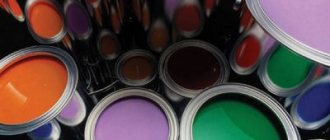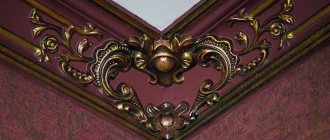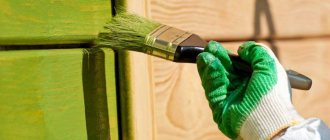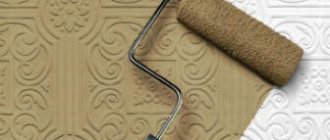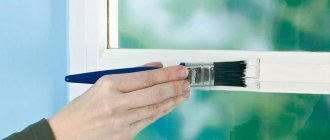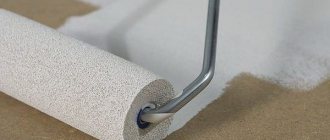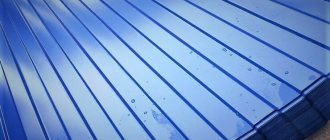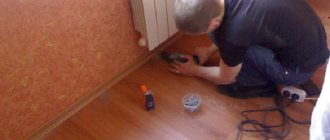Foam baseboards are usually used to decorate ceilings. It is attached under the ceiling covering itself and decorates the joint between the wall and the ceiling surface, giving a complete look to the room. However, some craftsmen and craftsmen prefer to use such a plinth to decorate the joints between the wall and the floor, because foam plinth is an inexpensive and easy-to-use material. But quite often those who make repairs are faced with a situation where the color of this product does not match the color scheme of the interior. How to paint a foam baseboard so that it blends in with the decor?
How to paint foam baseboard
Why paint the baseboard?
Some who read this article may ask a logical question - why paint such a skirting board at all, when you can buy a regular plastic one, which has a lot of colors, and install it? In fact, the interior of a room can sometimes have a rather unusual color scheme and choosing the appropriate shade from the existing ones simply won’t work. Sometimes you simply cannot find a skirting board of the desired color; this problem especially often arises in small towns with a modest market for construction products. Not everyone is ready to wait for such a plinth to be made to order, either, so they decide to paint it.
Foam baseboard
Foam plinth is easy to use, inexpensive, and even if some problems arise with painting, you can simply throw it away and buy new experimental samples - you won’t be sorry for the money spent.
Foam plinth opens up wide possibilities for its design - you can create quite unusual products that will easily become the highlight of the entire room and will undoubtedly attract the attention of guests. Also, sometimes ordinary floor skirting boards have a boring shape, while ceiling foam moldings are distinguished by their refined shapes.
Foam ceiling skirting boards
On a note! Installing a baseboard is usually the finishing touch to decorating a room. Without it, the interior will look unfinished. Therefore, you should not neglect their installation.
There are other reasons why some craftsmen decide to paint the baseboard:
- defective material was purchased, but I still regret the money spent . The situation will be corrected by sealing unevenness on the products with putty, and then applying a paint composition;
- sometimes an ordinary, unremarkable white piece needs to be transformed into an exquisite work of art . Using paint this can be done quickly and easily;
A plinth bent using cuts can also be painted.
- the paint can also hide the joints between the baseboards - then you get a monolithic-looking edging of the room. But so that they do not catch the eye, all products will have to be coated with a paint composition;
- paint also helps protect the baseboard from rapid loss of appearance, to which foam baseboards are prone . Over time, it wears out in any case, loses its former whiteness and looks ugly.
On a note! You can paint almost any skirting boards made from various materials. And the reasons for painting them are the same as for foam baseboards - protection from wear, decoration, design in accordance with the design of the room, etc.
Painting wooden baseboards
Installation of fillets
As we have already said, installing PVC ceiling plinth is a completely doable task even for a novice master. In most cases, such cladding is attached to a pre-assembled sheathing made of CD and UD profiles or wooden blocks. At its core, the plinth is a starting profile.
Scheme of installation of the structure.
Some sources say that profiles can be attached to perfectly flat walls or ceilings without lathing. This is true, but it makes sense to do such work on a base made of wood or plasterboard. It will take you a lot of effort, time and several Pobedit drills to fix the starting profile on the concrete floor slab every 150 mm. It is much easier to fill the crate here.
When it is ready, you can begin installing the baseboard itself. On both monolithic and split fillets, one of the sides of the end starting groove is several millimeters wider than the main structure. This allowance is made for attaching the baseboard to the base.
Fastening with a self-tapping screw to a metal profile.
The plastic fillet is attached to the sheathing of metal profiles using small metal screws. If the base is made of wood, then it is more convenient to use a construction stapler for fixation. Although, in the absence of one, you can use wood screws.
Beginning craftsmen often have difficulty cutting skirting boards in internal and external corners. To create a right angle, both adjacent plinth strips are cut using a miter box at an angle of 45º. Of course, plastic can be cut with a knife, but to ensure everything is accurate and neat, it is better to use a hacksaw.
Miter box for cutting corners.
But now there is simply no point in bothering with cutting corners on plastic PVC fillets. For these purposes, special fittings are produced, and the bar itself is cut at an angle of 90º and inserted into the groove of the adapter. This is incomparably faster than measuring and cutting profiles, plus such connections are guaranteed to have no distortions or cracks.
When is the best time to paint the baseboard?
Experienced craftsmen advise beginners to paint the baseboard even before installing it in its rightful place. Thus, with a 100% guarantee, you can protect already pasted wallpaper and the coated floor from paint getting on these surfaces. And the work can be done faster. The main thing is to first cut the baseboard into the required lengths and only then paint them. However, even after installing a painted plinth on the wall, you will have to repaint the joints between individual sections of elements.
Applying masking tape before painting
Skirting boards can be painted after installation. The procedure will be more complex and painstaking, but the paint (if even slight bending of the product is necessary due to uneven walls) will not crack. However, in this case it is important to protect the walls and floors from paint. The result will be much better.
Installation of foam floor plinth
Spray can or brush?
The painting technology depends on at what stage of the finishing work you decide to carry out this work. Coloring does not require special skills. Before applying paint, clean the baseboard from excess dust and dirt.
Spray can and brush for painting baseboards
It is better to use a brush to paint the panels . If the texture of your baseboard is quite complex, then it is better to use a spray can . The paint will lie more evenly, which cannot be said about applying paint to complex textures with a brush. We recommend applying it in a thin layer and smearing it well, otherwise it will collect in droplets and run down onto the walls after you remove the spatula. First, apply the base coat and let the paint dry. If you see unpainted joints, repeat the procedure.
Asterisk HELP! Brushes are best used when painting finished baseboards. If they are painted before installation, use a spray paint on the baseboard.
Knowing how best to paint, you can do it yourself without the help of specialists. Maybe,
Types of paints used for this type of work
Choosing the right paint composition is the key to accurate and durable work. Therefore, you should not buy the first paint you come across; it is better to first carefully study its composition and decide whether it is suitable for painting foam plastic. The paint composition should contain only water as a solvent.
How to paint the baseboard
Attention! For painting foam products, including baguettes, only those compositions that do not contain acetone and other similar solvents are used. This substance can simply melt the foam.
Table. Types of paints for painting foam baguettes.
| Type of composition | Description |
| Water-based | Paint has a low cost, therefore it is a frequently purchased material for painting various surfaces. The coating retains its brightness for many years. The surface painted with this paint can be cleaned with a sponge slightly moistened with water. |
| Water-dispersed | A material that is also suitable for painting most surfaces, including foam. It contains water and paint particles. As the painted layer dries, the moisture evaporates, and the paint particles join together and form a dense paint layer. The paint is inexpensive, and the work is very simple and convenient. Environmentally friendly and not hazardous to health. Products painted with this paint should not be cleaned with large amounts of liquid. |
| Acrylic | Refers to water-dispersible compositions. It is a universal type of paint and has the property of vapor permeability, which is why it is able to “breathe”. This coating does not fade in the sun and adheres very firmly to painted surfaces. |
| Latex | Also refers to a number of water-dispersion compositions. Optimal for rooms where there is a high level of air humidity - bathrooms, lavatories, toilets, kitchens, etc. It remains bright for many years and adheres well to the surface. This coating can be washed with water. But under the rays of light, latex paint quickly loses its color. |
How to cut a plastic skirting board
Installation of plastic skirting boards inevitably involves the need to cut and form beautiful joints in the corners. The overall quality of the entire work and the appearance of the room where the renovation is being carried out will depend on how the plinth is joined. Read more in this article on our website.
How to paint ceiling tiles
Updating a laminated ceiling by painting is not a difficult task even for a non-professional, but not every paint comes into contact with polystyrene foam without damaging the latter. Many compositions tend to dissolve polystyrene foam, so painting it with enamels containing acetone, white spirit, toluene, etc. is contraindicated. Experts do not recommend covering tiles with oil paint.
Repairs that are safe for foam panels can be made using 3 types of paints and varnishes. They are varieties of water-dispersed coatings and differ only in fillers. Usually painted with the following compositions:
- acrylic paint or varnish;
- water-based;
- latex paint and varnish material.
The compositions do not contain aggressive solvents and have good hiding power, although they have different prices. Restoring tiles with them is possible in a children's room, since the materials do not pose a threat to the child's health.
There is an affirmative answer to the question of whether it is possible to paint foam ceiling tiles, especially since manufacturers produce not only laminated colored panels, but also material specifically designed for subsequent painting.
In kitchens and bathrooms, the appearance deteriorates faster, because it is used in conditions of high humidity, so painting the ceiling tiles in these rooms provides additional protection to the finish and the ceiling itself.
Acrylic paint
It is made on the basis of polyacrylates and their copolymers, but it is odorless and harmless to health. The only drawback of this paint and varnish material is the high price, but this is offset by the following performance characteristics of the acrylic coating:
- resistance to changes in temperature and humidity;
- resistance to fading;
- color saturation.
Acrylic paint for ceiling tiles creates a durable glossy film on it. These compounds are easy to apply and dry quickly. Surfaces painted with them can be washed.
Water-based
You can update foam tiles with water-based paint. A composition based on a water dispersion of pigments and polymers creates a matte surface on the ceiling. Water-based paint is cheaper than other materials intended for painting tiles. To apply it, you can use sprayers, rollers and brushes. It lies evenly on the ceiling, well masking the seams between the panels. The coating has good vapor permeability.
Water-based paint is more prone to peeling and cracking. The coating does not withstand washing well. When finishing surfaces, especially in rooms with high humidity, it is better not to use white paint, as after a short time the ceiling will acquire a dirty gray tint.
Latex
Styrene-butadiene-based paint can create a matte or glossy surface. The moisture-resistant coating is elastic and resistant to ultraviolet rays. It is easy to apply and dries quickly. The disadvantage of paint is that it is not resistant to fungus formation. Paint applied too thickly will peel off.
Tips for choosing
Before painting foam tiles, it is better to find out what composition is suitable for painting indoor surfaces. The choice of a suitable means for updating the ceiling should depend not only on the design preferences of the apartment owner. What paint to paint tiles in the kitchen, bathroom or bedroom must be decided based on the characteristics of the paint coating.
When finishing surfaces, especially in rooms with high humidity, it is better not to use water-based and latex paints. In the kitchen and bathroom, it is advisable to use a more moisture-resistant acrylic-based composition. This material is better cleaned from contaminants.
If you still choose water-based paint, then the tiles in the bathroom and kitchen should not be painted white, as after a short time the ceiling will acquire a dirty gray tint. When choosing a composition for painting tiles, you need to remember that the applied coating may lighten or darken after drying.
Which paint to choose?
You need to select paint for painting foam moldings after clearly assessing the operating conditions of the finished products. That is, you should not buy compounds that are afraid of water for skirting boards that will be installed in the bathroom. So it all depends on where the products will be installed.
As for the paint color, everything is simple - you need to focus on your wishes and the color scheme of the interior. Usually the baseboard is decorated to match the main surfaces, that is, in this case, the floor. Sometimes it can be installed as an accent in a room, then it can have a different shade.
White baseboard goes well with gray walls
Advice! If the store does not have the paint color you need, you can purchase a regular white composition and add a color of a suitable shade to it.
To paint skirting boards that are not installed on the wall, you can buy paint in aerosol cans - working with it is convenient and quick. But for products already fixed in place, you will need to use canned paint and a regular brush. Otherwise, there is a risk of staining the floors and walls with the paint composition.
Application of aerosol paints
Features of the work
Plastic skirting boards, like any other surface, must be primed before painting. In this case, the paint consumption will be less (the baseboard is made of plastic - the material is porous), and it will lie much neater and smoother. By the way, the products can be primed even before cutting and fitting to the installation sites.
Another example of painting a floor plinth
If you need to paint a baseboard that has already been installed, then cover the walls and floor around it with masking tape. This measure will avoid damage to surfaces by paint. It is unlikely that without adhesive tape it will be possible to carefully decorate the glued-on baseboards even with the thinnest brush.
Attention! Don't use regular tape! It will leave sticky marks on the floor that are difficult to clean, and it can tear off wallpaper from the walls when removed.
By the way, during painting you can protect the walls and floor without using tape. In this case, a wide spatula is used, which is applied to the joint between the baseboard and the wall to protect the surfaces.
White foam plinth in the interior
It is advisable to apply paint to the baseboard in two layers - this way the surface will be painted better. However, the second layer is applied only after the first has at least partially dried. If you apply a lot of paint at one time, then there will be unpleasant streaks on the baseboards. When applied, the paint should rub well and spread over the surface. And it is applied with long and smooth strokes.
Advice! It is not advisable to use a newly purchased brush of poor quality to paint baguettes. Such a brush may leave bristles on the surface of the paint, which will ruin the appearance of the product if it is not removed. And this is unnecessary fuss during work.
Paint brushes
It is worth remembering: newly opened paint that is in a container looks somewhat brighter than the same paint that has already been applied and dried. And this aspect is important to consider when choosing the shade of the composition.
On a note! Before painting, the plastic plinth can be covered with plaster using a fine mesh. This measure will make it very durable.
Place a rubber band around an open paint can to wipe off your brush.
Preparing for coloring
Before you start painting the baseboards, you should prepare. To get started, it is recommended to purchase all the necessary materials:
- spatulas - wide metal and small rubber;
- masking tape;
- directly the paint itself of the desired color;
- narrow brush;
- rags;
- putty;
- primer mixture;
- sandpaper;
- varnish to finish the job.
Preparing the necessary tools
The baseboards themselves also need preparation for painting. To begin with, they are wiped with a damp sponge to remove dust and greasy stains. Also, if the baseboards are already installed, all joints between them are carefully sealed with putty using a small rubber spatula. In this case, you need to move from top to bottom in the direction of the seam. The curves of the baguette are repeated. After drying, the putty surface is sanded with sandpaper. In the same way, it is recommended to seal the joints between the wall and the baseboards. If necessary, putty can also be used to seal defects on the baseboard.
Advice! It is best to apply paint using a respirator to avoid inhaling harmful fumes. Gloves are used to protect hands.
Respirator for protection against odors when coating with varnishes and paints
The procedure for painting foam baseboards
Let's look at how the process of painting foam baseboards already installed on the walls occurs.
Step 1. The necessary preparatory work is carried out. Skirting boards are cleaned of dirt, puttied and primed. Only after this the painting work begins. First you need to open a can of paint, mix the composition well and, if necessary, add the color of the desired shade and in the required quantity.
Preparing the Paint
Step 2. Next, prepare masking tape - it is necessary to protect surfaces not intended for painting from paint. Floors can also be additionally protected with a covering film.
Masking tape
Step 3. Painting tape is glued to the wall along the top of the baseboard so as to cover it right next to the installed product.
Applying masking tape to the wall
Step 4. A covering film is laid along the wall on the floor, and the lower joint between the baseboard and the floor is also sealed with masking tape.
The bottom joint is sealed
Step 5. For ease of work, paint is poured into a special tray or cut-off bottle, into which the painting tool - brush, roller or other devices - will then be dipped.
Paint is poured into a tray
Step 6. The painting device is dipped into paint, the excess of which is removed by scraping it off on the edge of the tray. The paint is carefully applied to the baseboard. It is recommended not to go beyond the boundaries of the area to be painted, even though the surfaces are protected with tape and film.
Applying paint to baseboards
Step 7. After the paint has dried, the masking tape is removed. It is recommended to wait at least 4 hours before removing the adhesive tape.
At the end the tape is removed
If painting is done before fixing the baseboard to the wall using aerosol paint, then the product is placed on a film spread on the floor. Shake the can well before use to mix the paint. The composition is applied from a distance of at least 20 cm - only then will it be possible to avoid drips. After finishing the work and drying the paint layer, the surface of the plinth can be coated with varnish - it will protect the paint from rapid abrasion.
Video - Painting glued foam baseboards
Aerosol paint prices
spray paint
Video - Decorating foam baseboards
How to make effects?
Let's look at how to paint a ceiling plinth, giving it a certain texture using glaze .
Painting ceiling plinth using glaze
The most popular are:
- stone effect;
- gold effect;
- aged wood effect;
- patina effect.
Let's take a closer look at each of them.
Stone
To create the stone effect, you will need glaze (a type of tinting substance like stain) of a greenish tint and a swab made from pieces of leather or leather substitutes. It is applied to the base of the baseboard using a cotton swab and forms veins. The feather will help to color the veins with a light color.
Gold
to give a gilded effect . To begin, take a thin brush and a shade that suits your interior. Dip the brush into the paint solution and then wipe until almost dry. Apply the bristles to the embossed texture of the plinth, and then stretch along it, this will allow the gilding to remain on the embossed parts.
Aged wood
The effect of aged wood can be achieved using brown glaze and a brush with a hard structure. Apply using strong pressure. To form the fibers that are characteristic of wood, it is worth painting with paint a tone darker using a thin brush.
Patina
The patina effect is achieved using Taire color glaze. It is applied in a thin layer to the surface; do not paint the middle part. Next, take an old rag and blend the joints.
